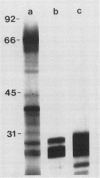Abstract
The initial step in tumor formation by Agrobacterium tumefaciens is the site-specific attachment of the bacteria to plant cells. A similar attachment to plant tissue culture cells has been observed. Binding to carrot suspension culture cells was not dependent on the presence of divalent cations and was not inhibited by the addition of mannose, α-methyl mannoside, galactose, arabinose, glucosamine, 2-deoxyglucose, or 0.25 molar NaCl to the culture medium. The ability of the carrot cells to bind A. tumefaciens was markedly reduced by elution of the cells with dilute detergent or CaCl2 or by incubation of the cells with proteolytic enzymes. The carrot cells were not killed by these treatments and recovered the ability to bind A. tumefaciens within 3 to 6 hours. A. tumefaciens did not bind to carrot cells which had been induced to form embryos (AG Matthysse, RHG Gurlitz 1982 Physiol Plant Pathol 21: 381-387). A comparison of the peptides eluted from embryos and from uninduced cells using sodium dodecyl sulfate-polyacrylamide gel electrophoresis showed that there were several changes in extractable polypeptides after embryo induction. One or more of the polypeptides present before embryo induction and absent from embryos may be involved in the binding of A. tumefaciens to the carrot cell surface.
Full text
PDF




Images in this article
Selected References
These references are in PubMed. This may not be the complete list of references from this article.
- Dazzo F. B., Hubbell D. H. Cross-reactive antigens and lectin as determinants of symbiotic specificity in the Rhizobium-clover association. Appl Microbiol. 1975 Dec;30(6):1017–1033. doi: 10.1128/am.30.6.1017-1033.1975. [DOI] [PMC free article] [PubMed] [Google Scholar]
- Douglas C. J., Halperin W., Nester E. W. Agrobacterium tumefaciens mutants affected in attachment to plant cells. J Bacteriol. 1982 Dec;152(3):1265–1275. doi: 10.1128/jb.152.3.1265-1275.1982. [DOI] [PMC free article] [PubMed] [Google Scholar]
- Laemmli U. K. Cleavage of structural proteins during the assembly of the head of bacteriophage T4. Nature. 1970 Aug 15;227(5259):680–685. doi: 10.1038/227680a0. [DOI] [PubMed] [Google Scholar]
- Lippincott B. B., Lippincott J. A. Bacterial attachment to a specific wound site as an essential stage in tumor initiation by Agrobacterium tumefaciens. J Bacteriol. 1969 Feb;97(2):620–628. doi: 10.1128/jb.97.2.620-628.1969. [DOI] [PMC free article] [PubMed] [Google Scholar]
- Matthysse A. G., Holmes K. V., Gurlitz R. H. Elaboration of cellulose fibrils by Agrobacterium tumefaciens during attachment to carrot cells. J Bacteriol. 1981 Jan;145(1):583–595. doi: 10.1128/jb.145.1.583-595.1981. [DOI] [PMC free article] [PubMed] [Google Scholar]
- Matthysse A. G. Role of bacterial cellulose fibrils in Agrobacterium tumefaciens infection. J Bacteriol. 1983 May;154(2):906–915. doi: 10.1128/jb.154.2.906-915.1983. [DOI] [PMC free article] [PubMed] [Google Scholar]
- Matthysse A. G., Wyman P. M., Holmes K. V. Plasmid-dependent attachment of Agrobacterium tumefaciens to plant tissue culture cells. Infect Immun. 1978 Nov;22(2):516–522. doi: 10.1128/iai.22.2.516-522.1978. [DOI] [PMC free article] [PubMed] [Google Scholar]
- Mellon J. E., Helgeson J. P. Interaction of a hydroxyproline-rich glycoprotein from tobacco callus with potential pathogens. Plant Physiol. 1982 Aug;70(2):401–405. doi: 10.1104/pp.70.2.401. [DOI] [PMC free article] [PubMed] [Google Scholar]
- Merril C. R., Goldman D., Sedman S. A., Ebert M. H. Ultrasensitive stain for proteins in polyacrylamide gels shows regional variation in cerebrospinal fluid proteins. Science. 1981 Mar 27;211(4489):1437–1438. doi: 10.1126/science.6162199. [DOI] [PubMed] [Google Scholar]
- Neff N. T., Binns A. N. Agrobacterium tumefaciens Interaction with Suspension-Cultured Tomato Cells. Plant Physiol. 1985 Jan;77(1):35–42. doi: 10.1104/pp.77.1.35. [DOI] [PMC free article] [PubMed] [Google Scholar]
- Ohyama K., Pelcher L. E., Schaefer A. In Vitro Binding of Agrobacterium tumefaciens to Plant Cells from Suspension Culture. Plant Physiol. 1979 Feb;63(2):382–387. doi: 10.1104/pp.63.2.382. [DOI] [PMC free article] [PubMed] [Google Scholar]
- Old D. C. Inhibition of the interaction between fimbrial haemagglutinins and erythrocytes by D-mannose and other carbohydrates. J Gen Microbiol. 1972 Jun;71(1):149–157. doi: 10.1099/00221287-71-1-149. [DOI] [PubMed] [Google Scholar]
- Salit I. E., Gotschlich E. C. Hemagglutination by purified type I Escherichia coli pili. J Exp Med. 1977 Nov 1;146(5):1169–1181. doi: 10.1084/jem.146.5.1169. [DOI] [PMC free article] [PubMed] [Google Scholar]
- Stuart D. A., Varner J. E. Purification and Characterization of a Salt-extractable Hydroxyproline-rich Glycoprotein from Aerated Carrot Discs. Plant Physiol. 1980 Nov;66(5):787–792. doi: 10.1104/pp.66.5.787. [DOI] [PMC free article] [PubMed] [Google Scholar]
- Wetherell D. F. Phytochrome in cultured wild carrot tissue. I. Synthesis. Plant Physiol. 1969 Dec;44(12):1734–1737. doi: 10.1104/pp.44.12.1734. [DOI] [PMC free article] [PubMed] [Google Scholar]





